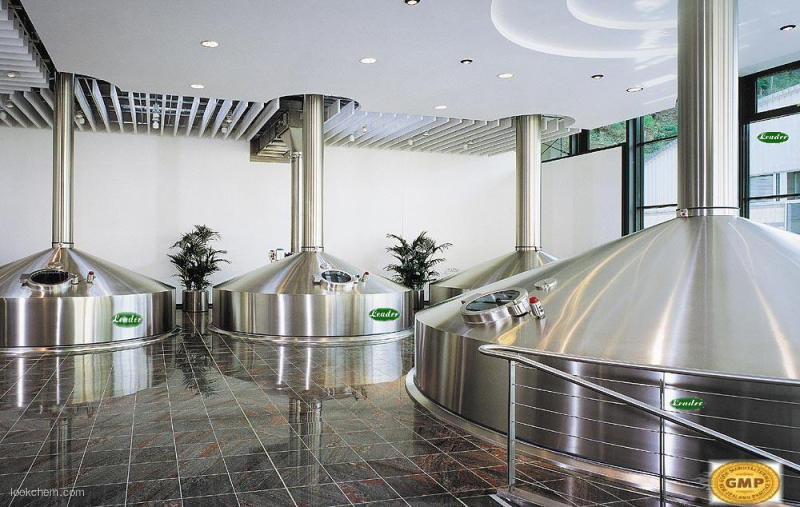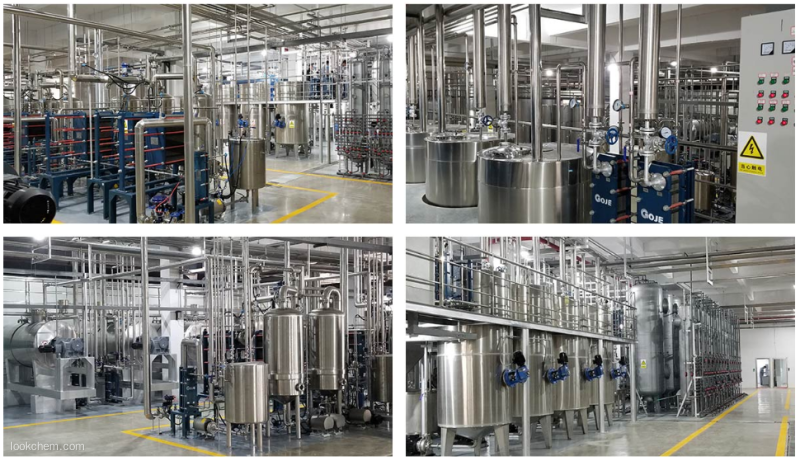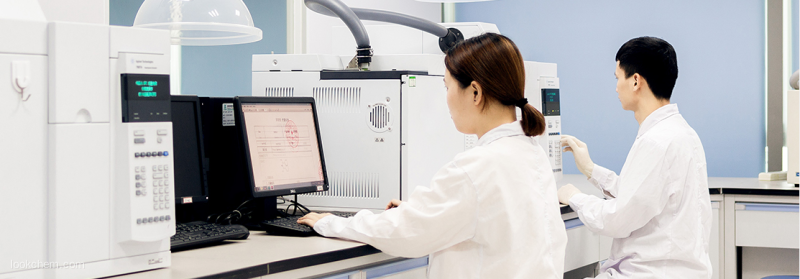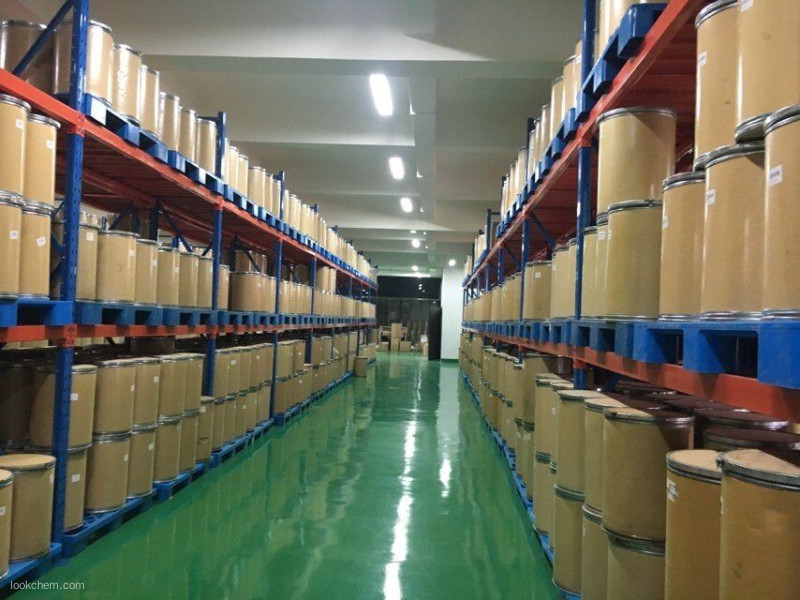PRODUCT DETAILS
| |
| Thiamine hydrochloride Chemical Properties |
| Melting point |
250 °C (dec.)(lit.) |
| density |
1.3766 (rough estimate) |
| FEMA |
3322 | THIAMINE HYDROCHLORIDE |
| refractive index |
1.6000 (estimate) |
| Fp |
9°C |
| storage temp. |
room temp |
| solubility |
H2O: 0.1 g/mL at 20 °C, clear, colorless |
| form |
Crystalline Powder |
| pka |
pKa 4.8 (Uncertain);9.0 (Uncertain) |
| color |
White to almost white |
| PH |
2.7-3.3 |
| Water Solubility |
1 g/mL |
| Sensitive |
Light Sensitive & Hygroscopic |
| Merck |
14,9295 |
| JECFA Number |
1030 |
| BRN |
3851771 |
| Stability: |
Stable. Combustible. Incompatible with strong oxidizing agents, strong reducing agents. |
| CAS DataBase Reference |
67-03-8(CAS DataBase Reference) |
| EPA Substance Registry System |
Thiamine hydrochloride (67-03-8) |
| Provider |
Language |
| Aneurine hydrochloride |
English |
| ACROS |
English |
| SigmaAldrich |
English |
| ALFA |
English |
| |
| Thiamine hydrochloride Usage And Synthesis |
| Description |
Thiamine Hydrochloride is the hydrochloride salt form of thiamine (vitamin B1), a vitamin essential for aerobic metabolism, cell growth, transmission of nerve impulses and acetylcholine synthesis. Vitamin B1 helps prevent various health problems including heart damage.
Thiamine hydrochloride is used to prevent and treat thiamine deficiency states, which may occur as a result of inadequate nutrition or intestinal malabsorption. It is also used for the treatment of Wernicke-Korsakoff syndrome, beriberi and thiamine deficiency related to chronic alcoholism. Thiamine hydrochloride is used as a food additive to add brothy/meaty flavor to gravies or soups. It is used also as a food supplement and flavoring ingredient with a bitter taste. |
| References |
[1] #
[2] Shmuel Yannai (2012) Dictionary of Food Compounds with CD-ROM, Second Edition
[3] # |
| Description |
In 1912, Cashmir Funk isolated thiamine from rice husks and coined the term ‘vitamine’ because it was required for life (‘vita’) and because thiamine contained nitrogen (‘amine’). Thiamine, formerly known as B1, is water soluble. Thiamine is a vital cofactor for enzymes and coenzymes of glycolysis, the Kreb’s cycle, the pentose phosphate pathway. Thiamine is also involved in the biosynthesis of the neurotransmitters acetylcholine and gamma-aminobutyric acid and in nerve propagation. |
| Chemical Properties |
White or almost white, crystalline powder or colourless crystals. |
| Chemical Properties |
Vitamin B1 has an odor slightly reminiscent of thiazole and a bitter taste. When exposed to air, the vitamin rapidly absorbs about 4% of water. |
| Occurrence |
Rice husks are reportedly the principal source of vitamin B1; in variable amounts it is a constituent of yeast, milk, green leaves, roots and tubers; it is also present in high concentration in seeds, and in lesser amount in different animal organs and muscles. |
| Uses |
Thiamine is the water-soluble vitamin b1, required for normal digestion and functioning of nerve tissues and in the prevention of beriberi. It also acts as a coenzyme in the metabolism of carbohydrates. During processing, the higher and longer the heating period, the greater the loss. The loss is reduced in the presence of acid. Thiamine hydrochloride and thiamine mononitrate are two available forms. The mononitrate form is less hygroscopic and more stable than the hydrochloride form, making it suitable for use in beverage powders. It is used in enriched flour and is found as thiamine mononitrite in frozen egg substitute and crackers. |
| Uses |
Thiamine is a essential nutrient required for carbohydrate metabolism; also involved in nerve function. Biosynthesized by microorganisms and plants. Dietary sources include whole grains, meat products , vegetables, milk, legumes and fruit. Also present in rice husks and yeast. Converted in vivo to Thiamine diphosphate, a coenzyme in the decarboxylation of α-keto acids. Chronic deficiency may lead t o neurological impairment, bariberi, Wernicke-Korsakoff syndrome. |
| Uses |
A cofactor required for oxidation of carbohydrates and for the synthesis of ribose. |
| Definition |
ChEBI: A hydrochloride obtained by combining thiamine chloride with one molar equivalent of hydrochloric acid. |
| Preparation |
By linking the preformed thiazole and pyrimidine ring system. |
| General Description |
Thiamine is a water-soluble vitamin of the B complex whose phosphate derivatives are involved in many cellular processes required for overall human health. Thiamine deficiency, often the result of impaired nutritional status associated with chronic diseases from alcoholism to HIV-AIDS, is monitored in patient whole blood samples by HPLC.
|
| Health Hazard |
Diseases and disorders resulting from a deficiency of thiamine include beriberi, opisthotonos (in birds), polyneuritis, hyperesthesia, bradycardia, and edema. Rather than a specific disease, beriberi may be described as a clinical state resulting from a thiamine deficiency. In body cells, thiamine pyrophosphate is required for removing carbon dioxide from various substances, including pyruvic acid. |
| Biochem/physiol Actions |
Thiamine is an essential coenzyme in carbohydrate metabolism. Deficiency of thiamine causes beriberi, a neurological and cardiovascular disease. Thiamine is administered in case of deficiency, either due to reduced intake or synthesis. Congenital defect in the thiamine transporter gene SLC19A2 causes thiamine-responsive megaloblastic anemia syndrome (TRMA). Thiamine mimics acetylcholine in brain and possible exerts a role in Alzheimer′s disease. Thiamine deficiency in ruminants causes polioencephalomalacia. |
| Safety Profile |
Poison by intravenous and intraperitoneal routes. Mildly toxic by ingestion. The vitamin is destroyed by alkalies and alkaline drugs such as phenobarbital sodium and by oxidzing and reducing agents. When heated to decomposition it emits very toxic fumes of HCl, Cl-, SOx, and NOx. |
| Environmental Fate |
Thiamine and its common phosphate analogs are readily soluble in water and ubiquitously utilized in nature. |
| Purification Methods |
The hydrochloride crystallises from 95% EtOH (solubility is ca 1%). The monohydrate is dehydrated at 100o in vacuo over H2SO4, but is hygroscopic and picks up one molecule of H2O readily. It can be sterilised at 100o if the pH of the solution is below 5.5. The nitrate has m 196-200o(dec) and is more stable than the hydrochloride. The picrolonate crystallises from H2O and is dimorphic, m 164-165o and 228-229o(dec). [Todd & Bergel J Chem Soc 364, 367 1937, J Am Chem Soc 58 1063, 1504 1936, 59 526 1937, Beilstein 27 IV 1766.] |
| |
| Thiamine hydrochloride Preparation Products And Raw materials |
|
|
|
|
|
|
Group profiles
Leader Biochemical Group is a large leader incorporated industry manufacturers and suppliers of advanced refined raw materials From the year of 1996 when our factory was put into production to year of 2020, our group has successively invested in more than 52 factories with shares and subordinates.We focus on manufacture Pharm & chemicals, functional active ingredients, nutritional Ingredients, health care products, cosmetics, pharmaceutical and refined feed, oil, natural plant ingredients industries to provide top quality of GMP standards products.All the invested factories' product lines cover API and intermediates, vitamins, amino acids, plant extracts, daily chemical products, cosmetics raw materials, nutrition and health care products, food additives, feed additives, essential oil products, fine chemical products and agricultural chemical raw materials And flavors and fragrances. Especially in the field of vitamins, amino acids, pharmaceutical raw materials and cosmetic raw materials, we have more than 20 years of production and sales experience. All products meet the requirements of high international export standards and have been recognized by customers all over the world. Our manufacture basement & R&D center located in National Aerospace Economic & Technical Development Zone Xi`an Shaanxi China. Now not only relying on self-cultivation and development as well as maintains good cooperative relations with many famous research institutes and universities in China. Now, we have closely cooperation with Shanghai Institute of Organic Chemistry of Chinese Academy of Science, Beijing Institute of Material Medical of Chinese Academy of Medical Science, China Pharmaceutical University, Zhejiang University. Closely cooperation with them not only integrating Science and technology resources, but also increasing the R&D speed and improving our R&D power. Offering Powerful Tech supporting Platform for group development. Keep serve the manufacture and the market as the R&D central task, focus on the technical research. Now there are 3 technology R & D platforms including biological extract, microorganism fermentation and chemical synthesis, and can independently research and develop kinds of difficult APIs and pharmaceutical intermediates. With the strong support of China State Institute of Pharmaceutical Industry (hereinafter short for CSIPI), earlier known as Shanghai Institute of Pharmaceutical Industry (SIPI), we have unique advantages in the R & D and industrialization of high-grade, precision and advanced products. Now our Group technical force is abundant, existing staff more that 1000 people, senior professional and technical staff accounted for more than 50% of the total number of employees, including 15 PhD research and development personnel, 5 master′ S degree in technical and management personnel 9 people. We have advanced equipment like fermentation equipment and technology also extraction, isolation, purification, synthesis with rich production experience and strict quality control system, According to the GMP required, quickly transforming the R&D results to industrial production in time, it is our advantages and our products are exported to North and South America, Europe, Middle East, Africa, and other five continents and scale the forefront in the nation, won good international reputation. We believe only good quality can bring good cooperation, quality is our key spirit during our production, we are warmly welcome clients and partner from all over the world contact us for everlasting cooperation, Leader will be your strong, sincere and reliable partner in China.
Our Factories production lines



Our Factories R&D ability


Our Factories warehouse




 Premiumsupplier
Premiumsupplier 



